Dr Vino's wine blog
wine talk that goes down easy
Lobstah and a surprising cavah
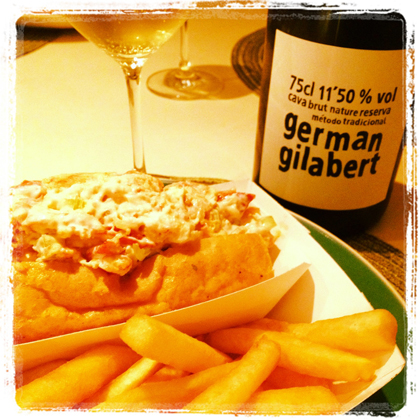 During the recent, week-long power outage, we sought refuge in an undisclosed location that may or may not have been the Commonwealth of Massachusetts. We found a bottle of “brut nature” cava German Gilabert (about $15; find this wine) at a local wine shop and got some lobstah rolls. This is hipster cava with a secondary fermentation in the bottle, six bar of pressure, no dosage and overall a very solid match!
During the recent, week-long power outage, we sought refuge in an undisclosed location that may or may not have been the Commonwealth of Massachusetts. We found a bottle of “brut nature” cava German Gilabert (about $15; find this wine) at a local wine shop and got some lobstah rolls. This is hipster cava with a secondary fermentation in the bottle, six bar of pressure, no dosage and overall a very solid match!
Interestingly, a little of the cava remained in the bottle and I left it on the counter. A couple of days later, I poured it in a glass and was surprised it was bubbly! I tasted it and it showed no signs of deterioration.
I asked the wine’s importer, Jose Pastor, via email for his thoughts on why this bottle held up so well. He was puzzled by the persistence of the bubbles, pointing out that he likes to decant many (grower) Champagnes and that reduces the fizz. As to the lack deterioration, he said that many of the (natural) wines from his portfolio often actually show better after being open a couple of days.
As several small producers in Champagne are making their bubbly more wine-like with less fizz, perhaps giving sparkling wines some air and serving in wine glasses will be a good way to go. What have you found in your experiments in giving bubbly some air?
Why importer Jose Pastor says “no, gracias” to Wine Advocate scores
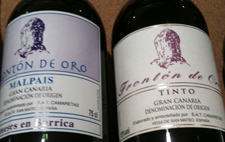 This week, our “set of titanium corkscrews” award goes to Jose Pastor. The 30-year-old Bay Area resident has a difficult business life selling Americans on the virtues of wines from such little-known grapes as Listan Blanco, Baboso, or Mantonegro from the Canary Islands and Mallorca. And since 2009, he’s added another challenge: selling his wines without Wine Advocate scores.
This week, our “set of titanium corkscrews” award goes to Jose Pastor. The 30-year-old Bay Area resident has a difficult business life selling Americans on the virtues of wines from such little-known grapes as Listan Blanco, Baboso, or Mantonegro from the Canary Islands and Mallorca. And since 2009, he’s added another challenge: selling his wines without Wine Advocate scores.
Citing fatigue of “living by the rule of the trade,” he told me at the recent tasting of his wines in New York that he has not journeyed to Maryland to present his portfolio to the Wine Advocate for two years. It’s also a philosophical difference over scoring.
“Wine is an agricultural thing,” he said. “You can’t score a tomato.”
He added that spending 30 or 40 seconds tasting a wine failed to capture everything about it. “You have to have a respect for the work that has been done. That’s hard to do without being there, meeting the people and seeing the land.”
So how does he sell his wine? He says that good retailers care how the wine got to the glass, not just whats in it, he says. He works with retailers such as Chambers Street Wines in NYC and Terroir in SF as well as restaurants.
“Things are really changing. People in the trade want to know more first-hand, to visit, to learn, to taste. And consumers too.” He says that it’s easier to undersand wine talk when it is coming from a fellow consumer, who describes a wine with food–or even over food, sharing the wine together. Then there are no points, no “chocolate and vanilla” descriptors.
“Back in the day, there were only two or three guys with a voice. Now there are many. It’s great for wine!”
* * *
The diversity that he celebrates in wine appreciation is also evident in his wines that represent one of the most exciting Spanish portfolios available in the US today. Read more…
Txakoli, albarino, Manzanilla and more! A Spanish tasting
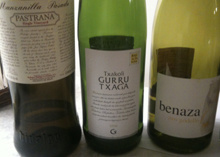 A group of friends that know each other through their sons’ school has a tasting every so often. I’ve been fortunate enough to lead the smart and fun group in about ten tastings over the past couple of years. Our most recent tasting explored the exciting category of Spain beyond the fruit bomb, focusing on indigenous grapes, values, and/or off-the-beaten-path regions. Read more…
A group of friends that know each other through their sons’ school has a tasting every so often. I’ve been fortunate enough to lead the smart and fun group in about ten tastings over the past couple of years. Our most recent tasting explored the exciting category of Spain beyond the fruit bomb, focusing on indigenous grapes, values, and/or off-the-beaten-path regions. Read more…
Traditional Rioja, the anti-en primeurs wine
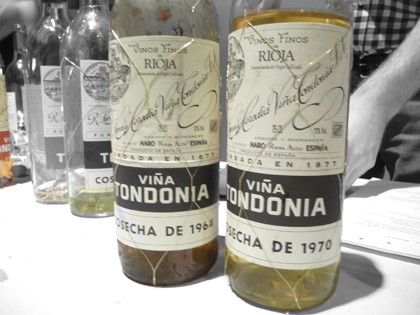
Why pay en primeur prices for young Bordeaux that won’t arrive for two years? A case against en primeur certainly comes in the form of the traditional Riojas from R. Lopez de Heredia. Read more…
Ribeira Sacra is en fuego when the weather is hot
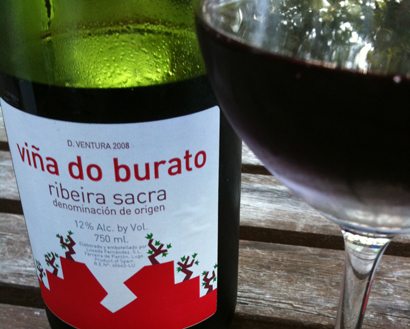
I keep meaning to do a comparative tasting of wines made from the mencia grape. But every time I get a bottle, I drink it!
Case in point: D. Ventura’s Vina do Burato, 2008 (about $19). Weighing in at a spare 12% alcohol, this is a great summer red, perfect for chilling and serving dining outside. It’s reminiscent of a cru Beaujolais, although a tad darker in color, but with that same lively acidity, bright fruit and scoring highly on the drinkability scale.
Last year, Eric Asimov of the NYT explored the winemaking renaissance in Ribeira Sacra, the vertiginous region in northwestern Spain where this wine came from (check out the story and the gorgeous photos that make you want to book your tickets there right now). The maker of this wine is Ramón Losada, a full-time veterinarian descended from generations who have toiled the terraces in the region to make wine. He told Asimov “I make money on the wine, but not enough to live on, which gives me the freedom to make wine however I want. Some urge me to change, but I won’t.” Excellent!
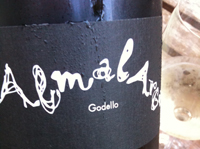 Thanks to a tip from Chris Barnes at Chambers Street Wines, I tried a bottle of Godello from the region too. The Almalarga 2008 from Pena Das Donas ($22) was also low in alcohol (12.5% on the label). It was a Goldilocks wine–not too hot/cold, big/small, comfy/not comfy–it was, “just right.” The 80-year-old vines produce a wine with pleasant acidity and some stoniness of a Chablis and good richness thanks to aging on the lees. The only things holding this silky, drinkable wine back from white wine world domination are the presumably limited quantity of production and the slightly high price.
Thanks to a tip from Chris Barnes at Chambers Street Wines, I tried a bottle of Godello from the region too. The Almalarga 2008 from Pena Das Donas ($22) was also low in alcohol (12.5% on the label). It was a Goldilocks wine–not too hot/cold, big/small, comfy/not comfy–it was, “just right.” The 80-year-old vines produce a wine with pleasant acidity and some stoniness of a Chablis and good richness thanks to aging on the lees. The only things holding this silky, drinkable wine back from white wine world domination are the presumably limited quantity of production and the slightly high price.
Wine Future in Rioja – opening Pandora’s bottle of grenache
 So the King of Spain, 18 bottles of Grenache, and a man wanted by Interpol walk into a conference in Rioja. Sound like the start of a bad joke? Welcome to the reality that is Wine Future!
So the King of Spain, 18 bottles of Grenache, and a man wanted by Interpol walk into a conference in Rioja. Sound like the start of a bad joke? Welcome to the reality that is Wine Future!
The two-day Wine Future Rioja 09 event next month will showcase a long list of wine luminaries including Jancis Robinson, Oz Clarke, Steven Spurrier, Gary Vaynerchuk, Jorge Ordonez, and Robert Parker.
The pinnacle of the wine summit will be a premium tasting with Parker (who will be meeting King Juan Carlos during his trip, Parker’s first to Spain since 1972). Limited to 450 attendees, the VIP tasting costs 217€ but can only bought in conjunction with the 783€ conference ticket. Parker and the organizer selected a lineup of 18 grenache based wines, seven from Chateauneuf-du-Pape, five from other parts of Spain, two from California (including one aptly named Pandora), and four from Australia.
Can you imagine a top-dollar tasting in Napa Valley, sponsored by the Napa Valley Vintners, that showcased the wines of the Rhone, Australia, and Argentina?
Grenache, of course, is not the top dog in Rioja, land of Tempranillo. So the local hosts and sponsors of the event took afront and after much protest that included the regional Partido Riojano joining the fray. Now, two wines from the Rioja have been added, the Marqués de Riscal de 1945 and a Contador 2007. Neither of those wines contains any grenache.
But the drama doesn’t end there. The event organizer, Pancho Campo, has resigned from his position to “focus on clearing his name” according to Decanter. In 2003, a court in Dubai found him guilty in abstentia in a dispute stemming from his time as an event organizer and promoter in Dubai. Jim Budd has a thorough round-up of the evidence; Manuel Camblor has been writing about the events recently in Spanish on his blog La Otra Botella.
Is sherry’s retro image ripe for a makeover? On public radio’s Marketplace
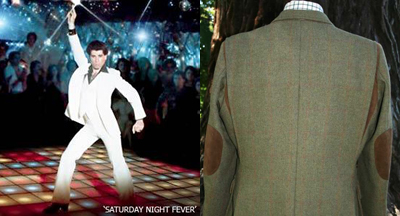
In August, I dropped by the Manhattan studio of the public radio show Marketplace studio and chatted with reporter Caitlin Carroll about sherry. She was interested in it since apparently the Sherry Promotional Council has a $1 million promotional effort under way to rehab the drink’s retro image. The story aired yesterday (listen here) saying that part of the campaign involves putting sherry in the hands of sommeliers and chefs to get people pouring the drink again.
The following weekend, I tried exactly that. We met up with some college friends at a Rhode Island home just a stone’s throw from the ocean. I brought several bottles of wine and threw in a bottle of Lustau fino that I had picked up at Astor Wine to try out on the guinea pigs–er, our friends. The hors d’oeuvres included some crab cakes but no marcona almonds, which are a great match.
The wine was universally panned. One guy wouldn’t even taste it saying, “It reminds me of my grandmother.” It then flooded him with memories of his grandmother and he regaled us with tales from his youth. But he still wouldn’t taste it. “Is there any Sauvignon Blanc?” someone else asked. Another guy soldiered on and almost finished his glass. Surprisingly, the crab cakes didn’t help the situation.
What do you think? Is sherry, the darling of wine writers and some sommeliers, poised to be retro chic or remain simply retro? Some of you have recommended a fino here in food pairings, such as gazpacho. Food really is key. Assuming people will even try it.
Related: Apera, topaque, vintage, lickoffable – Aussie fortifieds grasp new names
Three bubblies, Fox Business, and a mystery
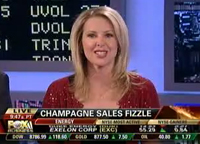 On Wednesday I went on Fox Business–for the second time in a week! The video for this segment is available (see it by clicking on the image at right).
On Wednesday I went on Fox Business–for the second time in a week! The video for this segment is available (see it by clicking on the image at right).
We continued the discussion of “trading down” that we started last week, this time with a focus on bubbly, as the day demanded. Since I didn’t get a chance to actually mention the Dibon cava brut reserve (about $11; find this wine) on the show, I’ll do so here: it’s some really easy drinking stuff, great for parties, or to accompany coconut fried shrimp, as I did recently (it sure beat Lipitor, which could have also worked for that dish). I brought the tasty Roederer Estate brut NV on the show as well (find this wine). And for those who really didn’t want to trade down–or simply prefer fine Champagne in the winter, as I do, economic climate be somewhat damned–I brought the Larmandier-Bernier, brut, premier cru, blanc de blancs (about $45; find this wine). It’s a fantastic example of a grower Champagne and one of my favorites.
So here’s the big mystery question: since they didn’t allow us to pour wine on the set, what bubbly was actually in our glasses at the end?



